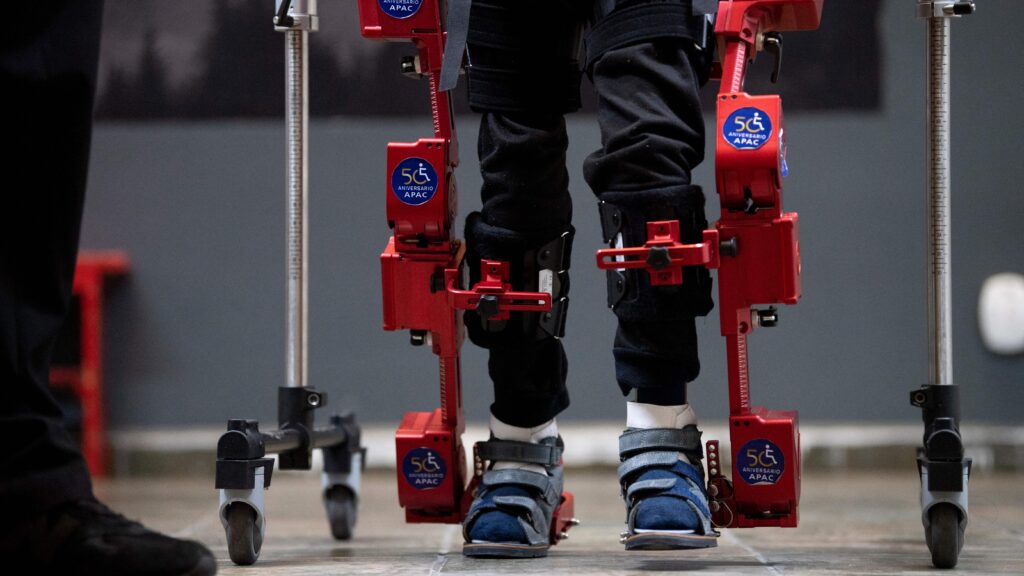For many kids with cerebral palsy, walking is taxing. They might spend thousands of hours step-stepping in physical therapy to make walking easier. In recent years researchers have developed robots to aid this rehabilitation.
A new JAMA Network Open study from a team in South Korea found that exoskeletons can improve a child’s gait, balance and motor function. This randomized clinical trial, which had about 90 children participating, is one of the largest studies to test the efficacy of robot-assisted gait training. Studies investigating robotic rehabilitation in kids are typically quite limited, said Chandramouli Krishnan, who directs the Neuromuscular and Rehabilitation Robotics Laboratory at University of Michigan.
advertisement
“It removes or minimizes the inequity in rehab research and shows that studying these technology-based interventions for children is important,” said Krishnan.
However, the Michigan professor is quick to point out that the study’s gains are somewhat pedestrian — only a 2.7% increase in gross motor function. This measures several functions, such as lying, crawling, standing, and walking. Cerebral palsy is the most common pediatric motor disability, with roughly 10,000 kids born with the neurologic condition in the United States every year. Over 40% of this population uses a hand-held mobility device to walk or cannot walk. For robots to replace conventional physical therapy, the gains will likely need to be higher, said Krishnan.
Some studies show that exoskeletons are effective gait trainers for people who have a stroke. And robotic systems such as the Lokomat have been used in clinics for years, and a gait trainer from Trexo Robotics has generated buzz in the industry, too. Two 2022 studies found no discernible benefit and inconclusive evidence for robot-assisted gait training for kids with cerebral palsy. The steep costs of these devices combined with modest improvements may deter many physical therapists from buying and deploying them in their clinics. Authors of the study did not respond to STAT’s interview requests by publication time.
advertisement
“If you’re really into exoskeletons, I think you’re going use this [study] as a reason to support exoskeleton progress,” said James Sulzer, a biomedical engineer at University of Texas at Austin. “If you’re a skeptic of exoskeletons, you’re going to note that…the effects look fairly modest.”
To see if robots could help kids with cerebral palsy, the authors had the study participants wear an Angel Robotics exoskeleton and walk around variable terrain like ramps and stairs for 30 minutes, three days a week, for six weeks. The control group received conventional physical therapy for a similar amount of time. When the authors assessed the participants’ motor function, they found clinically significant changes in measures like gait patterns and balance.
The participants logged nearly 1000 steps per session. While most exoskeletons constantly guide the user and offer a predetermined trajectory, the Angel Legs allow the wearer to move under their own power but with a small boost. Sulzer was impressed by this torque-assisted exoskeleton, as it requires more active participation from the wearer.
“If you’re really trying to retrain someone who has some active control over their legs, moving someone in a trajectory is not going to teach them how to walk,” Sulzer said.
When the study authors followed up with participants four weeks after the therapy, the improvements were sustained. Krishnan believes these gains are legitimate, but the study’s design worries him. Every person with cerebral palsy has varying levels of motor function, so the experimental and control group often did not start from the same baseline. It’s more difficult to determine an intervention’s effect in such cases.
Krishnan doesn’t think that the technology’s demonstrated benefits overcome the financial burden it will impose. But he sees the vision of what it could offer to clinicians.
“The biggest advantage of robotics is dosage. It’s not fair to expect a robot to outperform a PT,” he said. “But if it can be taken home, or even in a clinic, right, if it doesn’t require therapists’ supervision too much, the time of treatment can be increased.”
The appetite for robotic-assisted gait training is growing in rehabilitative medicine. But it’s still slim pickings for kids — which makes it tough for clinicians to take the plunge, said Sulzer.
“If they had it at the clinic, I would certainly be interested and want to try it out, after seeing those results,” he said. “But would you, if you were the clinician, buy the thing? Is it going to be worth the cost?”

